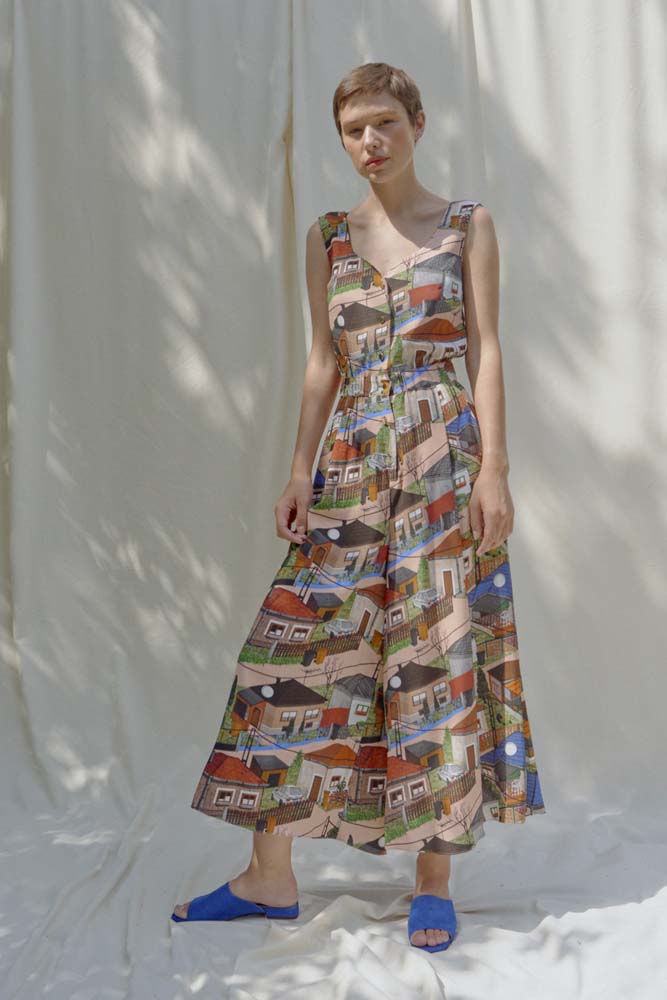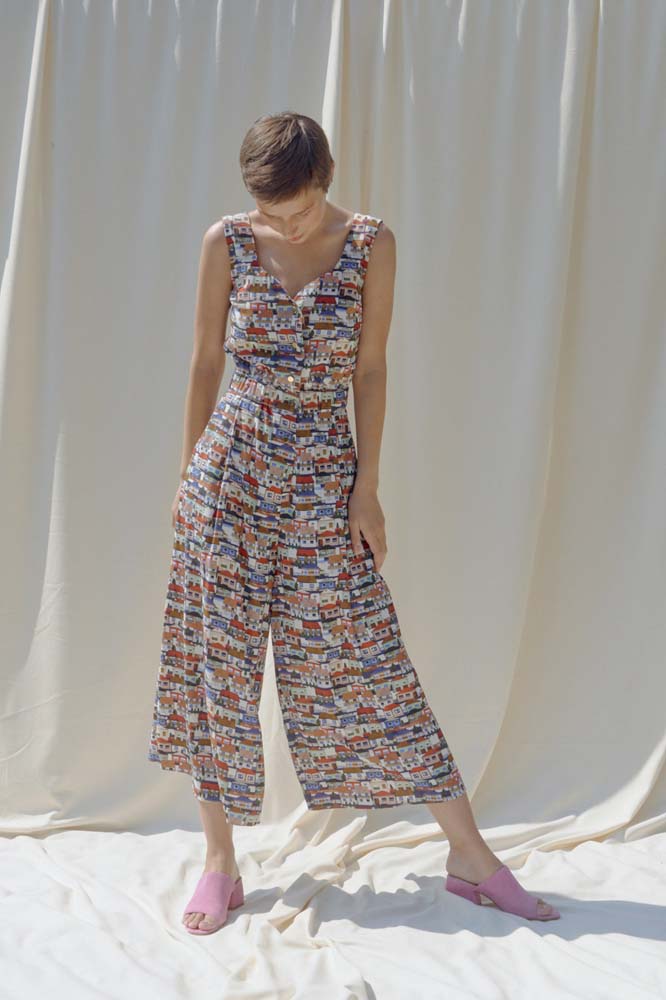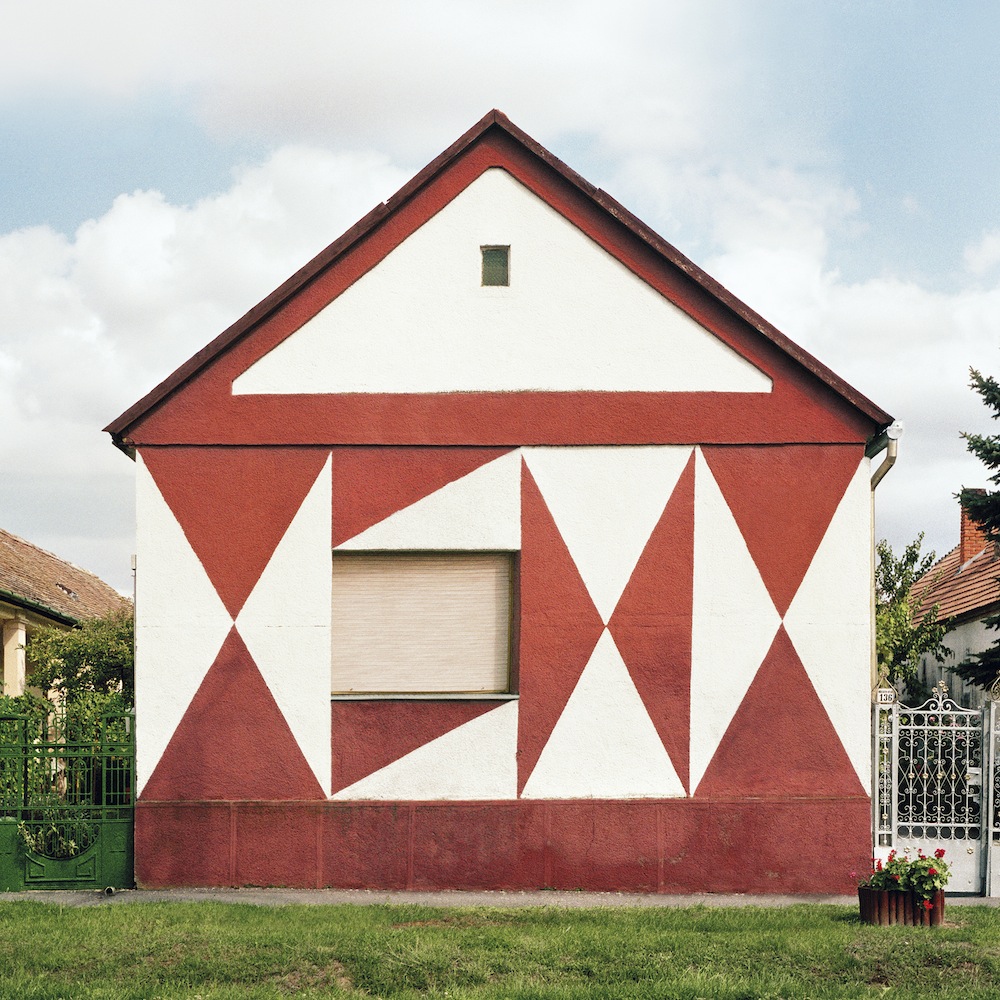The Kádár cube comeback: how the humble Hungarian home inspired high-fashion and eco-friendly living
Kádár cubes are a defining feature of the Hungarian landscape. There are approximately 800,000 of these square houses with tent-like roofs spread across the country, usually in small villages and built between 1960 and 1980. Yet, for a long time, the small structures have reminded Hungarians of the painful Soviet era, a time which the country has only just started to confront. Most of the buildings are in bad shape, with their older inhabitants (often the same people who built the houses in the first place) unable to renovate them. Many have been left empty and are crumbling.
But while Kádár cubes were long out of fashion, the tiny houses are being revitalised by young people. Increasingly, images of colourful Kádár cubes are appearing on the internet, on the websites of art magazines, and trendy social media pages.
Known in Hungarian as Kádár-kocka, the houses were named after the General Secretary of the Hungarian Socialist Workers’ Party at the time of their construction: the pro-Soviet János Kádár, who replaced the stricter Mátyás Rákosi after Hungary’s 1956 uprising and stayed in power until 1988. It was under Kádár that Hungary entered a new era of relative liberty (at least compared to neighbouring East Germany or Romania), cultural freedom, and comparatively high standards of living, earning the country its reputation as the “happiest barrack” of the Soviet Block. These three decades were dubbed Goulash Communism (after Hungary’s national, traditional, meaty soup) for providing citizens with a degree of wealth and food aplenty. The country was changing, and part of that development was the building of new houses: tower blocks in cities, and Kádár cubes in rural areas.
From Hungarian Cubes: Subversive Ornaments in Socialism (2014) by Katharina Roters
The Kádár cubes were especially disruptive when they first emerged. “With the appearance of the Kádár cube, most of the identity of the Hungarian village disappeared,” explains Tamás Kondor, a professor of contemporary architecture at the University of Pécs. In reality, their distinctive cube form came from the changing demands and lifestyles of rural families. After the Second World War, factories lured workers from agriculture, transforming families’ traditional daily routine of labouring in the fields. Electricity became more widely available, and families could start equipping their homes with appliances like fridges and electric lighting. Many more wanted to have a bathroom inside the house, rather than in the garden.
At the same time, family models were also changing across Europe as a whole. Fewer people wanted to live within an extended family, leaving the nuclear family of parents and children as society’s most important building block. People also demanded more privacy, a change many associate with the appearance of phones, radios and later cassette players, devices which enabled people to spend time without others, in separate spaces. These demands were hardly compatible with old Hungarian farmhouses, which offered fewer rooms that opened out from each other.
From Hungarian Cubes: Subversive Ornaments in Socialism (2014) by Katharina Roters
As Kondor makes clear, all of this contributed to Kádár cubes’ “compact layout”, where rooms were connected via a corridor, and modern amenities included a built-in bathroom and kitchen with modern appliances. With financial loans and building materials suddenly widely available, many families decided to build a Kádár cube of their own— a perfect modern home.
Nevertheless, as Kondor explains, “the Kádár-cube didn’t exactly translate into [practical] rural buildings.” For starters, many homes simply couldn’t keep heat inside, and as they were built from cheaper, poor quality materials, many started breaking down.
After the collapse of the Soviet Union, Hungary turned to more modern, Mediterranean-style buildings, particularly in rural areas. The Kádár cubes, along with their urban counterparts — the much maligned tower blocks — were condemned as ugly, useless, and quickly faded into the background.
From Hungarian Cubes: Subversive Ornaments in Socialism (2014) by Katharina Roters
Katharina Roters is among a new wave of figures responsible for Kádár cubes’ recent renaissance. The German-born painter and photographer moved to Hungary after the collapse of communism. Fascinated by the variety of decoration in the country’s rural homes, she began documenting the nation’s joyfully symmetrical buildings with a 6x6 camera. Between 2004 and 2011, she took hundreds of images of Kádár cubes’ colourful facades, editing out clutter such as flowers, antennas and cables in post-production. Hoping to preserve her work as a book, she contacted sociologist József Szolnoki, who added the necessary context about the ornaments and appearance of Hungarian villages, as well as changes to domestic interiors.
Looking for funds for the project within Hungary was very hard, said Roters. “Even now, I feel like [these buildings] are a very loaded topic in Hungary. This is exactly why it’s so interesting,” she said. In the end, Hungarian Cubes: Subversive Ornaments in Socialism was realised without the help of Hungarian funds. It was released in 2014 in Switzerland by Park Books, and won the DAM Architectural Book Award that very same year.
The book became an international success and, crucially, caught the eye of young Hungarian creatives, who began to look kindly on this piece of their country’s heritage. One such creative designer is Hungarian fashion designer Dóra Tomcsányi, whose Spring/Summer 2019 collection was a tribute to Kádár cubes. “For every season, I find inspiration from my childhood,” she said. Praised by the fashion industry and shoppers alike, the collection presented the Kádár cubes in a new light: stylish, aesthetically pleasing, and unique to the country.
More artistic tributes followed. Kádár cubes were integral to the plot of Hungarian sci-fi short Kaliedoo. They have inspired the pastel-coloured minimalist paintings of fashion designer and artist Anna Sibitka, and the monochrome ornaments of Barbara Pattern’s illustration series, Heritage Details. The hashtag #kádárkocka is booming on Instagram, with posts from young Hungarians showing off their Kádár cubes renovations. Accounts such as @kockajuci, @rustiube_otthon, and @housewithgreywindows have thousands of families.
“[When I moved,] I asked just one thing: that we don’t buy a Kádár cube,” said Dorka Lángi, a brand manager who moved out of Budapest during the pandemic. She ultimately ignored her own request and bought one of the structures for herself. Now, she documents the transformation of her Kádár-cube on Instagram for an audience of 10,000 followers. “I mean, what do people know about Kádár cubes? That they are ugly. So when I imagined my home for the next 30 years, I didn’t imagine this.” Both Lángi and her husband, Ferenc Márk Tóth, grew up in Székesfehérvár, a town close to the capital. A little more than a year later, they moved there, and into their renovated Kádár-cube.
One of the main reasons attracting younger generations to Kádár cubes is their affordability: houses are available from as little as 10 million Forints (£25,000). “We tried to concentrate on the fact that there are many possibilities in this 10x10 square metres space,” said her husband Tóth. “We knew that if we worked with decent professionals, it would be worth it in the end.”
Now, the walls and foundations are the only part of Tóth and Lángi’s Kádár-cube to remain unchanged. Everything else was re-done: the floorplan and windows were changed, they extended the balcony, and renovated the roof. One year in, the pair are adding doors and kitchen appliances, and are quite excited for what they call their “eco cube”. The house’s iconic tent-like roof makes adding solar panels easy, and the structure is now energy-efficient. “We are trying to get our carbon-footstep close to zero,” Tóth explained. “Kádár cubes might be an invention of the 20th century, but it is possible to save them, rejuvenate them and place them in the 21st century.”
They are not the only Millenials interested enough to buy a cube. “It’s a relatively cheap option for young people looking for property to buy,” explains Tamás Kondor, the professor from the University of Pécs. In a response to rising demand, the Hungarian government recently released 21 free renovation plans, specifically designed for the ubiquitous home. Ranging between two to six rooms, the renovations cost from 30 to 70 million Forints (£73,000 to £170,000) — costs which are affordable with easily-accessible family loans.
For many, buying a Kádár cube comes with a sense of homecoming. According to a recent survey, half of all Hungarians either live, or have lived, in a Kádár cube. “Almost every family has one,” Kondor said. In 2019, he worked alongside staff from the University of Miskolc and the Blidai Saad Dahlad University in Algeria, to design an eco-friendly Kádár cube. Renamed the Hungarian Nest+, the project was entered into the Solar Decathlon, a collegiate competition to design the eco-friendly homes of the future.
Hungarian Nest+
The team tweaked the original Kádár cube structure — adding an atrium to introduce lots of natural light and move air throughout the building. In place of the small porch, they designed a “thermostat bubble” around the building, with moveable and changeable walls. The area can function either as a balcony or a conservatory, depending on the season.
The concept won four major prizes and, more importantly, proved to be both desirable and livable. According to research, today, roughly a third of Hungarians would buy a Kádár cube of their own.
Hungarian Nest
According to Katharina Roters, time and distance has made it easier for Hungarians to process this architectural part of their recent past. She believes that Hungary has arrived at a point where it can appreciate the Kádár cubes, beyond their Soviet context, and save them from decay. For new generations, the personal traumas and collective memory of the Socialist era are fading.
As a result, Kádár cubes, that were once the signifiers of a new age of modernity, perhaps can be so can be so again: cheap and compact, sleek and sustainable, they might just be the homes of the future.







